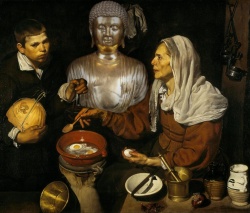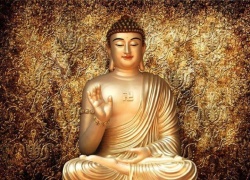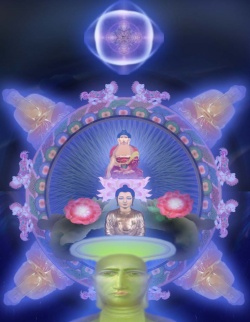Svadhishthana
Svadhishthana (Sanskrit: स्वाधिष्ठान, IAST: Svādhiṣṭhāna, English: "one's own base"), or sacral chakra, is the second primary chakra according to Hindu Tantrism.
Svadhishthana is illustrated as a white lotus (Nelumbo nucifera).
It has six vermilion-colored petals inscribed with syllables: बं ban, भं bhaṃ, मं maṃ, यं yaṃ, रं raṃ and लं laṃ. Inside this lotus is a white crescent moon which represents the water region presided over by the deity Varuna.
The seed mantra, located in the innermost circle, is a moon-white वं vaṃ.
Above the mantra that is within the bind, or dot, is the deity Vishnu.
He is dark blue and wears a yellow dhoti. He holds a conch, a mace, a wheel and a lotus.
He wears the shriwatsa mark, and the koustabha gem. He is seated either on a pink lotus, or on the divine eagle Garuda.
His strength is the goddess Rakini (or Chakini).
She is black, dressed in red or white and seated on a red lotus.
She is commonly depicted with one face and two arms, holding a sword and a shield, or two faced and four armed, and holds a trident, lotus, drum and vajra, or an arrow, skull, drum and axe.[citation needed]
The six petals represent the following modes of consciousness, also known as vrittis:
affection, pitilessness, feeling of all-destructiveness, delusion, disdain and suspicion.
Svadhishthana is associated with the unconscious and with emotion.
It is closely related to the Muladhara in that Svadhishthana is where the different samskaras (potential Karmas) lie dormant, and Muladhara is where these Samskaras find expression. It is associated with the element of water, the sense of taste and the act of procreation.
Svadhishthana contains unconscious desires, especially sexual desire. It is said that to raise the kundalini shakti (energy of consciousness) above Svadhishthana is difficult .
Many saints have had to face sexual temptations associated with this chakra.
One who meditates on Svadhishthana is believed to obtain the following siddhis or occult powers: freedom from enemies, the status of a lord among yogis, eloquence and clarity ("words flowing like nectar in well-reasoned discourse"), loss of fear of water, awareness of astral entities and the ability to taste anything desired for oneself or others. Association with the body
Svadhishthana is located near the coccyx (tailbone), two finger-widths above the Muladhara chakra. Its corresponding point in the front of the body (i.e. its kshetram) is the pubic bone.
It is connected with the sense of taste, (the tongue) and with reproduction (the genitals).
It is often associated with the testes and ovaries. They produce the hormones testosterone or estrogen, which influence sexual behaviors. They are stored in areas where genetic information lies dormant, in the same way that samskaras lie dormant within Svadhishthana.
Practices in kundalini yoga to control and balance the energy in Svadhisthana chakra include vajroli mudra (contraction of the genitals), ashvini mudra (contraction of the anus), and various asanas and pranayamas.
Comparisons
The equivalent chakra in the Vajrayana tantra systems of Tibet is called the "Secret Place" four fingers below the navel.
It is red in colour, with 32 downward pointing spokes.
Meditation on this point produces great bliss.
According to certain interpretations of Sufism, the spiritual body of a man is defined as an interconnected system (Lataif-e-sitta), in which there is an energy center called the nafs.
According to Lataif-e-sitta, the nafs is just below the navel.
14. There is another Lotus, placed inside the Sushumna at the root of the genitals, of a beautiful vermilion color. On its six petals are the letters from Ba to Puramdara i.e., La, with the Bindu Anusvara superimposed, of the shining color of lightning.
15. It is the white, shining, watery region of Varuna [i.e. Water is the governing element of this Chakra, of the shape of the half- moon; and therein, seating on a Makara an alligator-like [[mythological] creature], is the Bija Vam, stainless and white as the autumnal moon.
16. May Hari, who is within it [i.e., Vishnu, who is seated in the "lap" of the Bindu of Vam -- who is in the pride of early youth, whose body is of a luminous blue that is beautiful to behold; who is dressed in yellow raiment, is four-armed, and wears the Shri- vatsa and the Kaustubha -- protect us!
17. It is here that Rakini always shines. She is of the color of a blue lotus.
The beauty of Her body is enhanced by Her uplifted arms, holding various weapons.
She is dressed in celestial raiment and ornaments, and Her mind is exalted with the drinking of ambrosia [i.e. She drinks the nectar dripping down from the Sahasrara, and is exalted by the Divine Energy that infuses Her].
18. Those meditating upon this stainless Lotus, which is named Svaashisthaana, are freed immediately from all their enemies, such as the fault of Ahakara Egoism and so forth.
They become masters among Yogis, and are like the Sun illuminating the darkness of ignorance Moha.
The wealth of their nectar-like words flow in prose and verse, in well-reasoned discourse.
From the Sat-Chakra-Nirupana
"The Svaadhisthaana Chakra is of the color of vermilion, and has six petals. On its six petals are the six letters Ba, Bha, Ma, Ya, Ra and La, with the Bindu placed thereon.
The letters are the color of lightning.
"In the pericarp of this Lotus is the region of Water in the form of an eight-petalled Lotus, with a half-moon in its center.
This region is white. Inside this latter is the Varuna-Bija "Vam," seated on a Makara with a noose in his hand. in the lap of Vam (i.e. in the hollow of the Bindu) is Vishnu seated on Garuda.
He has four hands, and is carrying the shankha conch-shell, chakra [[[Wikipedia:discus|discus]]], gadaa [mace], and padma lotus.
He is dressed in yellow raiment, wears a Vanamaalaa [long garland round his neck, the mark Sri-vastsa and the gem Kaustubha on his breast, and is youthful in appearance.
"On a red lotus in the pericarp is the Shakti Rakini.
She is Shyaama-varna, and in Her four hands She holds the shula spear or trident, abja lotus, damaru drum and tanka [battle-axe].
She is three-eyed and has fierce projecting fangs [kutila-damstrii], and is terrible to behold.
She is fond of white rice shuklanna, and a stream of blood runs from Her nostril."
From The Serpent Power, by Sir John Woodroffe, 1919
"There are seven spinning wheels of energy in you. If you pay attention to the actions given below carefully and remember them, you will experience these spinning wheels. ...
"2. Swadhishtana is the six-petal wheel.
This is the sex center.
A trishul shaped like a yoni is within a six petal wheel.
It has an orange color and a white moon adorns it.
At this place, the vibrations of sex keep going round and round like a wheel.
This is the original seat of the transcendental Goddess, and the meaning of 'Swadhistana' is that the Shakti resides there.
From there, the sound of Vang Vam rises to the crown.
This is the seed sound of nectar, being a rose color, a mixture of semen-white and blood-red.
The clitoris is the seat of Kundalini, identifiable with the Snake God Kumara."




